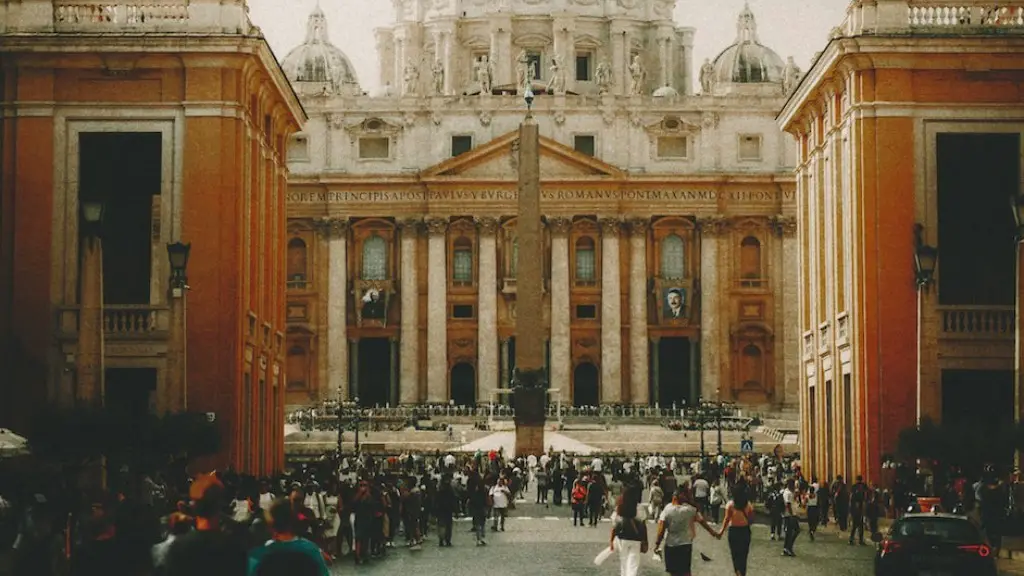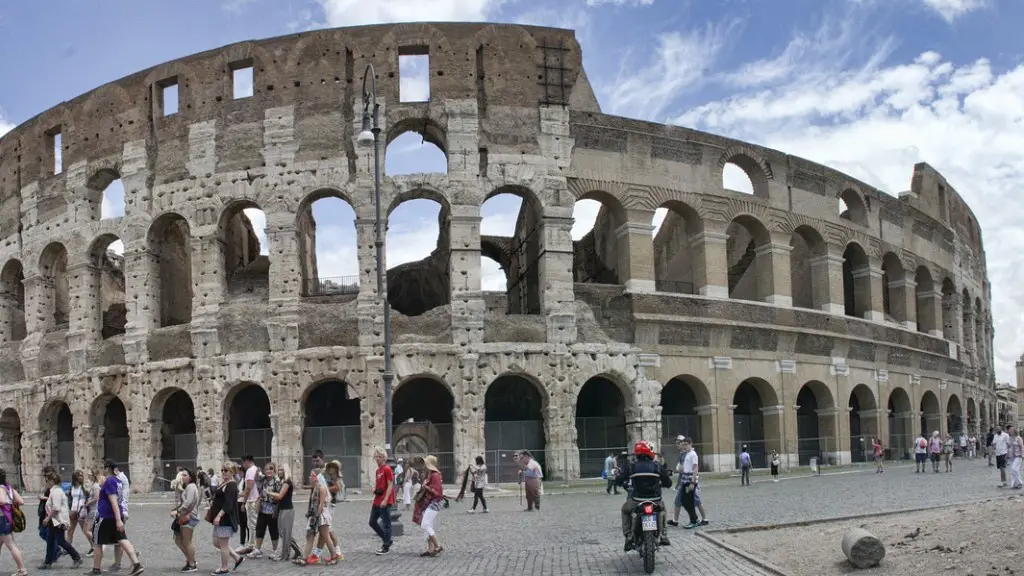The Forum
The Forum was the heart of Ancient Roman life. It lined the streets of the capital, Rome, and beyond. It was here where public speeches were made, legal cases were heard, religious ceremonies were honored and commerce was conducted. For centuries, the Forum served as a physical and spiritual center of the Roman Empire.
How did most Ancient Romans live? The Forum was the place where the majority of Roman citizens would come to get the goods and services they needed for their daily lives. The streets were lined with shops that sold clothing, food, tools, and other goods. Large markets could be found within the Forum, where vendors from throughout Italy, and even from the furthest reaches of the empire, would sell their wares. As well as being a hub for commerce, the Forum also played a critical role in the political life of Rome. It served as the site of public speeches, political debates, and even elections.
Institutes
The majority of Ancient Romans were members of institutes, or guilds. While by no means mandatory, joining an institute provided the Roman citizens with a great many benefits. Institutes often provided insurance, guild halls which members could use for meetings and relaxation, and special privileges. By joining and contributing to an institute, a Roman citizen could also earn more respect and recognition in the community.
Members of institutes would often live in large, communal buildings. These were, in many ways, the precursors to the apartments of today. With communal kitchens and public bathing rooms, they provided Romans with all the amenities they needed to live comfortably. Members of the upper classes, who had a bit more leisure time on their hands, were known to have a penchant for luxurious living, with elaborate bathrooms and even heated courtyards.
Villas and Countryside
Wealthy Romans and members of the higher classes of society often had the opportunity to escape the hustle and bustle of the Forum and the cities by retreating to their villas in the countryside. The most notable of these were known as “Villa di Manius,” comprising dozens of homes that could belong to a single family, some of which had their own resources such as livestock, farms and orchards.
These villas could be quite sumptuous, often with large walled gardens and decorative courtyards. There are stories of villas being filled with exotic plants, staffed by servants and even fed by aqueducts. Such luxuries enabled the Ancient Romans to entertain lavishly and revel in the beauty and tranquility of their surroundings. Many of these villas still stand today and give us a glimpse into their former residents lavish lifestyles.
The Poor
The less affluent members of Ancient Roman society usually lived in much more modest dwellings, often housed in the same city blocks as their wealthier counterparts. These dwellings served multiple purposes, often including homes, shops, and even public bathhouses, all within a single building. These dwellings were usually quite cramped, with members of a single family often living in the same room. For the less fortunate, life was hard and they were at the mercy of the elements and whatever work they could find to sustain them.
Suburbs
For those who found the sprawling city life of Rome to be too much, there were options outside the city center. Suburbs in the nearby cities, towns and villages could provide a more peaceful and relaxed way of life. Here Ancient Romans could find homes that were removed from the hustle and bustle of the capital or in quiet cities or towns that provided much of the same goods and services as Rome, but with a more tranquil atmosphere.
Today, the suburbs are home to tens of millions of people and have become the archetype of living for many in the Western World. In Ancient Rome, this was a much more common way of life for citizens to escape the megalopolis that was Rome. This is just one way in which Ancient Romans were opting for something less hectic and more affordable outside of the city center.
Military and Colonies
By the time of the Roman Empire, one of its most common provinces, Italica, had been established as an outpost of the Roman Empire in the north of Italy. As such, many Romans resided there, either as part of a military assignment or simply as colonists who were sent to expand the Roman Empire.
Similarly, Roman military personnel were often stationed in other colonies and foreign cities. This gave rise to numerous Roman settlements throughout Europe, North Africa and the Middle East. These nooks and crannies of the Roman Empire provided a unique way of life for those who lived there and could provide a great variety of exciting experiences, such as witnessing the law courts, taking part in religious ceremonies, engaging in commerce and interacting with diverse cultures and religions.
It is thus evident that the vast majority of Ancient Romans lived in and around Rome. This does not only include people from the capital, but from a variety of settlements near and far, in the form of villas, institutes, suburbs, military outposts and colonies. Ancient Rome was, in many ways, the heart of Europe, and its success was due in no small part to the people who lived and worked there. From average citizen to the wealthiest families, it truly was a place bustling with life and culture.
A Growing City
In addition to the many different areas and communities that Ancient Romans called home, Rome itself was usually under constant expansion. New structures were built to accommodate a growing population, both within the city and beyond its walls. As more people moved to the capital, existing homes were taken over, with larger buildings constructed to cater for the influx of new citizens. With the surrounding areas being constantly developed and adapted, Romans had even more options for living away from the city center.
More importantly, many Ancient Roman buildings, monuments and structures still stand to this day and give us a unique window into the past. From the Forum to the villas, from the cities to the colonies, these places have been preserved and give us an insight into a unique and vibrant past.
The Roman Empire
By the end of the 1st century BC, the Roman Empire encompassed much of Italy and most of Europe, stretching from Britannia in the north to Egypt in the south. This meant that large numbers of citizens were living in foreign lands. In some cases, they were able to experience a more exotic lifestyle with access to a wider range of goods and services. In other cases, they were sent to military outposts in distant places, in order to bolster the strength of the Roman legions abroad. As time passed, many of these outposts grew into bustling cities, filled with Roman citizens.
The extent of the Roman Empire meant that there were many different climates and terrains that Romans had to contend with. This was true for citizens living in the extreme north, to those living in more tropical climates. As such, Ancient Romans had to be versatile in their approach to living. Some had the luxury of villas, while others had to make do with modest dwellings. Regardless, the Roman Empire was populated by diverse citizens who fashioned their lives in different ways.
Religion
Religion was an important aspect of Ancient Roman life. While officially polytheistic, with some of the gods and goddesses worshiped by the Romans being Romanized versions of gods and goddesses from other cultures, monotheistic religions such as Judaism and Christianity were also prominent. This is why we see places of worship in Rome that cater to different sects, from simple temples to grand cathedrals.
The variety of faiths amongst Ancient Romans meant that different communities had their own unique gatherings, rituals and practices. For example, at the large synagogue in Rome, Jews would gather for prayer, followed by meetings and other services. Similarly, Christian communities would also have large gatherings and ceremonies, culminating in grand feasts or Mass in the cathedrals. No matter a person’s beliefs, religion was an integral part of life in the Roman Empire.
Conclusion
From citysiders in Rome to the far-reaching corners of the Roman Empire, Ancient Romans lived interesting and varied lives. Throughout their empire, they were able to experience many different cultures, lifestyles, beliefs and attitudes, all within the Roman way. From luxury villas and bustling markets to simplistic dwellings and remote outposts, Ancient Rome was an eclectic mix of life and culture.


